Ann Mah's Blog
January 16, 2018
My new novel

I’m thrilled that my new novel, The Lost Vintage, will be published this summer! It’s a story about wine, World War II, and family secrets that have been buried for generations.
The book will be in stores on June 19, 2018, and I’m honored that it’s already received advance praise from some of my favorite writers:
“The world needs novels like The Lost Vintage: page-turning tales that remind us both of the power of the human spirit and the mystery of the human heart. The Lost Vintage moves seamlessly between the indignities and horrors of occupied France in the Second World War and the pride and passion of serious winemakers in the present. It’s a remarkable novel.”
–Chris Bohjalian, bestselling author The Flight Attendant and The Sandcastle Girls
“Weaving together past and present and all the complex history of France’s relationship with the German occupation of the Second World War and the secrets that are still kept, Ann Mah’s The Lost Vintage is a delightful novel–part love story, part mystery–that unfolds layer after layer of nuance and depth until its symphonic finish and reads like nothing so much as one of the vintage Burgundy wines that are so much part of the story.”
–Tilar J. Mazzeo, bestselling author of The Widow Clicquot and The Hotel on Place Vendôme
The book is currently available for pre-order, but if you can’t wait until June, you can read the first chapter (for free!) along with excerpts from 39 other fabulous 2018 books via Publishers Lunch Buzz Books.
And, stay tuned for updates – including info on special giveaways, and more – in my monthly newsletter! If you don’t already subscribe you can sign up here.
As always, thank you from the bottom of my heart for all your continued support.
Amitiés,
Ann
SaveSave
SaveSave

June 22, 2017
Smoked salmon tarte flambée
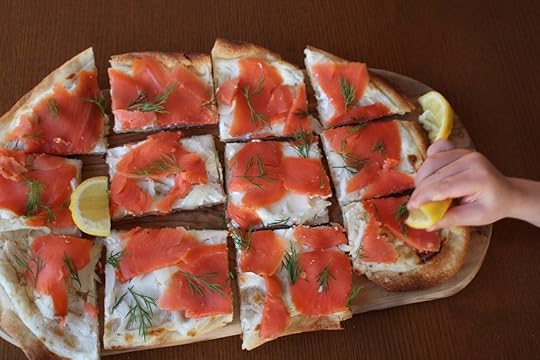
Four years equals 1,460 days, which is approximately the number of sunsets I’ve watched from the windows of our apartment on the 35th floor. I know – four years, already! It’s gone by in the blink of an eye, hasn’t it? And yet, impossibly, here it is, summer 2017, and the baby who was still on the inside when we arrived is now a walking, talking, almost-four-year-old who loves elephants, puzzles, and princesses, and who would eat rice and salmon for every meal if we let her.
If you read this blog (or my book – or my newsletter), you probably know where this post is going. Yes, it is time for this diplomatic family to pack up and move once again – in less than a week, we will be relocating to Washington, D.C.
Obviously, moving makes everyone anxious, but this time I’m peeling away extra layers of nostalgia, as we say goodbye to the first home our daughter has ever known. These past four years have been very busy, and very sweet. When I think back to that steamy summer of our arrival, I remember how terrified I was by the major life changes ahead (and, as it turned out, I was right :) But somehow we managed to navigate life with a new baby, insane work hours, and an apartment building that shuts off the water almost every Tuesday – somehow, unbelievably, I managed to write two new books – and along the way we discovered another side of the city that never sleeps, a playful side of park sprinklers and ferryboat rides, a tender side where the old biddies hold open doors for moms pushing strollers, and the doormen greet your kid every morning with a high five.
New York still is the most fascinating, energizing city I’ve ever known. I have never felt more at ease in any other place in the world, more comfortable in my own skin, or more confident about life’s possibilities. Yes, New York still is, to me, the greatest city on earth. And yet, I also feel it’s time to go. One by one, my dearest friends have slipped away, out of state, or to the suburbs. But it’s more than that – it’s also the city’s constant need to make a buck, usually at my expense and/or inconvenience. The predatory landlords. The capital renovation projects. The mom-and-pops that disappear only to be replaced by another Walgreens. The hustle, the hustle, the hustle. I used to think I could stay here forever, and maybe that’s still true. But we don’t have that choice and, honestly, a little break doesn’t sound so bad.

As well, there is something else to soften our departure – our apartment in Paris. Even though it’s a shoebox, it’s forever our shoebox, and I am so grateful to have this permanent home, a place that remains steady and unchanging as the rest of our life gets turned upside down. A refuge. It is a huge comfort.
Anyway. All this topsy-turviness has been making me think about those anxious days before our last move, in particular the last trip we took before the baby was born. It was June 2013, and my husband and I had hopped a TGV to Strasbourg so I could research choucroute garnie. But because I don’t really like choucroute garnie (sorry!), I ended up eating a lot of tarte flambée, or flammekueche, a snappy, thin crusted tart spread with crème fraîche, onions, and lardons of bacon.
I fell secretly in love with flammekueche on that trip, but I never made it at home because it seemed too rich and decadent, with its layers of pork fat and cream. But recently, I was playing with some ideas for meat-free French cuisine, and I had a brainwave – what if I replaced the bacon with smoked salmon?

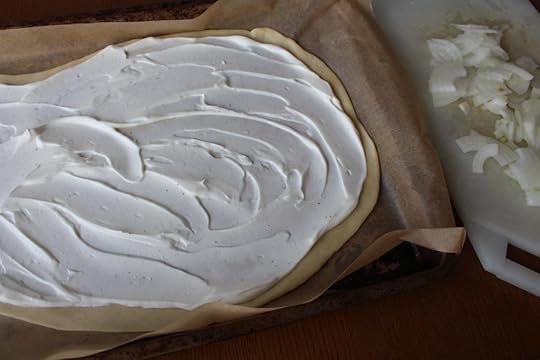


The recipe is actually really simple, even though it involves dough, and dough is usually the devil. The crust – just flour, water, salt, and oil – needs no leavening, which means there’s less to mess up, and no tedious rise-time. Just mix the ingredients together, and roll the dough into a lovely, thin sheet. Spread it with seasoned sour cream, and sprinkle over generous handfuls of slivered onions. Slide the tart into a hot oven until the edges turn golden and the bottom turns crackly. Then, let the tart cool for a few minutes before draping it with smoked salmon. Dill sprigs are also lovely, a spritz of lemon adds punch, fried capers would be delicious – but perhaps that’s gilding the lily. Cut the tart into squares and you have the best combination of New York and France that I can think of.

Enjoy it with the sunset.
I can’t bear to say goodbye to New York, so instead I will say what I always say to Paris: à bientôt.
Smoked salmon tarte flambée
Makes one large, oval tart; serves 4-6 as a snack
For the dough:
2 cups (250 grams) all-purpose flour
1/2 teaspoon salt
3 tablespoons olive oil
2/3 cup tepid water
For the toppings:
1/2 cup sour cream
1/4 teaspoon salt
Freshly ground black pepper
1 small onion, peeled and thinly sliced
6 ounces smoked salmon
Dill
Lemon wedges, for serving
In a large bowl, combing the flour, salt, and oil. Using a fork, slowly stir in the water, drop by drop, until a soft dough forms. You may not need all the water.
Turn the dough onto a clean, floured work surface. Knead until all the flour is incorporated and the dough becomes smooth and elastic, about 1 minute. Cover and set aside.
Preheat the oven to 500ºF. Line a baking sheet with parchment paper.
In a small bowl, stir together the sour cream, salt and pepper.
On a floured work surface, roll the dough into a large oval, approximately 10 x 16 inches. Transfer the dough to the parchment-lined baking sheet.
Spread the sour cream evenly over the dough leaving a 1/2-inch border. Distribute the slivered onions in an even layer.
Bake until the tart is well-browned and golden at the edges, about 15 minutes. Remove from the oven, allow to cool for 5-8 minutes, and then arrange the smoked salmon slices on top. Sprinkle with dill. Slice into squares, and serve immediately, squeezing over a wedge or two of lemon, if desired.

May 24, 2017
The New York Times Footsteps + giveaway!
The first literary pilgrimage I ever made was to Stratford-Upon-Avon. I was twelve or thirteen, traveling in England with my parents, and I remember standing inside Anne Hathaway’s cottage and thinking “Shakespeare breathed inside these walls, he stepped on these floors.” I was awed.
From Dickens’s London, to Hemingway’s Paris, I have always loved traveling through the footsteps of my favorite writers – and I also love writing about these kinds of trips, and reading about the experiences of others, too. Now my favorite column in New York Times Travel has a new book, The New York Times: Footsteps, which collects these literary pilgrimages from around the world. I’m super excited and honored to have three of my essays collected within – L.M. Montgomery in Prince Edward Island, Bram Stoker in Whitby, and Elena Ferrante in Naples – but aside from these pieces, the book features some of the best travel writing I’ve ever read, including Dan Saltzstein on Dashiell Hammet’s San Francisco, Tony Perrottet on Lord Byron and Shelley in Lake Geneva, and Matt Gross on Marguerite Duras in Vietnam. Even if you’re not planning a trip, but merely seeking a bit of armchair escape, this book offers a wealth of inspiration. After all, as Monica Drake explains so beautifully in her introduction, “True literature itself is a flight of fancy,” and this volume is the perfect companion.
I hope you’ll check out the book and pick up a copy for you and your favorite traveler. I’m also delighted to be giving away five copies, courtesy of Three Rivers Press / Penguin Random House. Details to enter are below. Good luck – and may literature always be your guide!
GIVEAWAY!
Thanks to Three Rivers Press / Penguin Random House, I’m thrilled to be giving away two (2) copies of The New York Times: Footsteps (open to U.S. residents only).
To enter, subscribe to my newsletter here. (If you are already subscribed, you are automatically entered.) Winners will be selected at random and announced here on May 31.
For a more chances to win the giveaway, visit my author page on Facebook and enter there.

May 19, 2017
Acquacotta by Emiko Davies
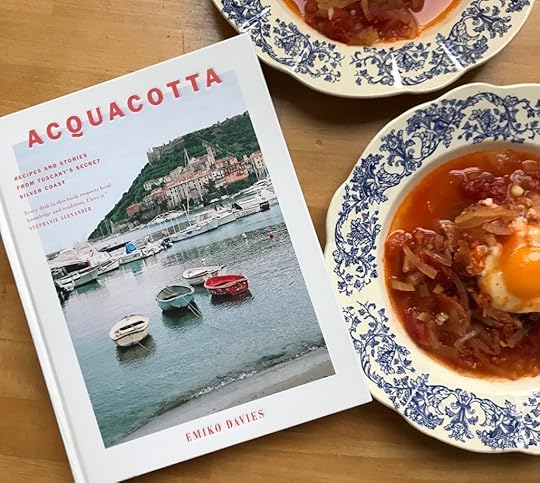
Acquacotta means, literally, “cooked water,” but as cookbook author Emiko Davies would tell you, it’s so much more. It’s a soup simmering with all the nostalgia of comfort food. It’s a recipe that stretches to feed an army. It’s a symbol of a region, the Maremma, a strip of land bordering the Tyrrhenian sea, a place so beautiful and magical it completely captured Emiko when she moved there with her family in the warm months of 2016. Last but not not least, Acquacotta is a cookbook, a collection of photographs, memories, and recipes lovingly gathered by Emiko during the six months she spent in this secret silver coast of Tuscany.
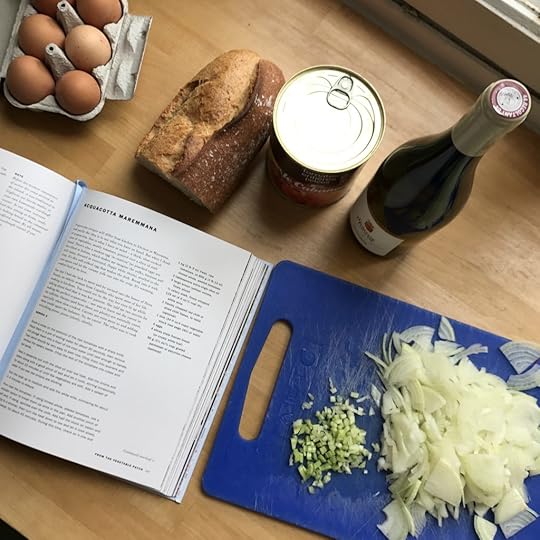
Emiko and her family now live in Florence, Italy, and I was lucky to meet her there a few weeks ago. We shared an impeccable lunch at Sostanza (butter chicken, artichoke omelette, Tuscan beans, and a bitter leafed salad) and could have talked for hours about food, writing, and our shared experiences as expats in Beijing, and diplomatic family life. Of course we also talked about her new book, and the Maremma region, which I had never heard of. But later that day, after a long walk, and visit to a palazzo perched on the banks of the Arno (as you do, when in Firenze), we parted ways – and I suddenly began to see references everywhere to the region. There it was on the wine list, a remarkable, lush white, full of stone fruits. There it was on the street, a sign proclaiming “Acquacotta,” the name of a little restaurant. There it was in the Sant’Ambrogio food market, labelling a pile of plump ricotta-stuffed pasta called tortelli maremmanni.
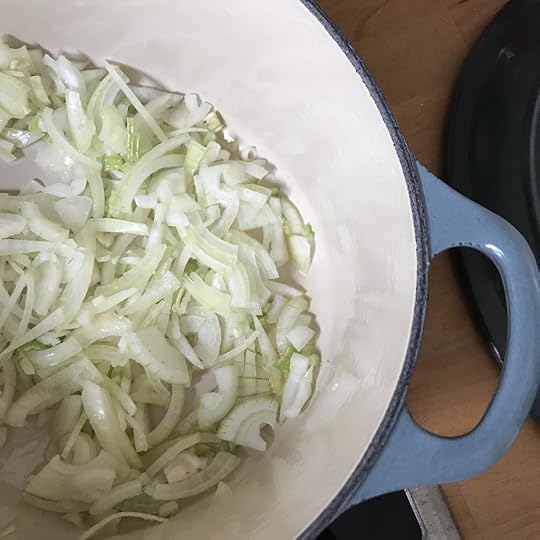
I wish I could have visited the Maremma. Instead, I had the next best thing – a copy of Emiko’s beautiful cookbook. Back in Paris, I spent a long time leafing through its pages, absorbing Emiko’s location photography, reading the stories and recipes she had gathered so carefully. On a cold, grey spring day nothing seemed more appealing than the acquacotta itself, a simple tomato soup stretched nourishing with stale bread and a poached egg – a poor man’s feast. I carefully simmered the ingredients “piano piano” – softly, softly – as Emiko instructed, and while they gently bubbled, it occurred to me for the thousandth time how recipes are the best souvenirs. Recipes – and friends, too. On this trip, I feel like I made a new one.
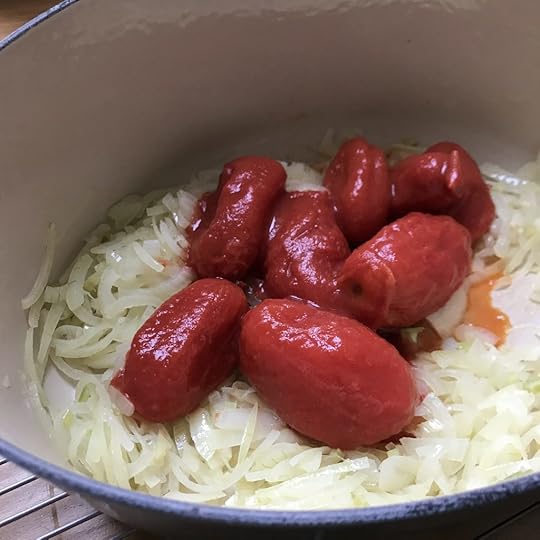


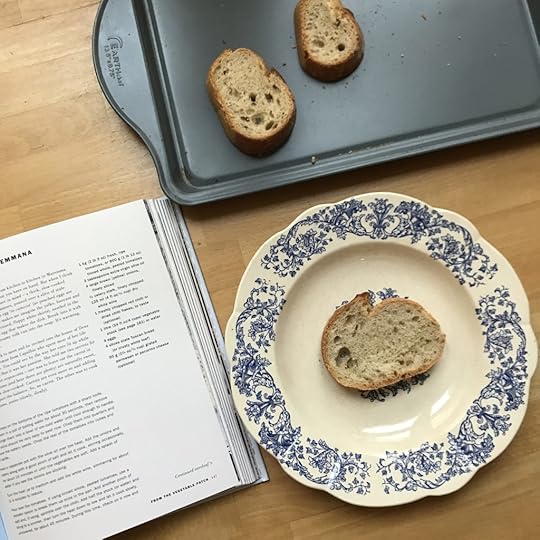
Acquacotta (tomato soup with bread and poached egg)
Adapted from Acquacotta by Emiko Davies
I halved Emiko’s original recipe, but somehow it still made enough for four portions. You can use peeled, fresh tomatoes instead of canned, and stock instead of water. The bread should be stale, not toasted – toasting alters the flavor, as Emiko points out – and so I dried my slices in a low oven.
Serves four
1.5 tablespoons extra-virgin olive oil
2 onions, peeled and finely sliced
1/4 stalk celery, finely chopped
Salt
1/4 dry white wine
1 14.5-ounce can (4o0 grams), peeled tomatoes
1/4 teaspoon chile flakes (or more to taste)
Water
4 eggs
4 slices Tuscan bread (or crusty white loaf), preferably stale
Warm the olive oil in a large Dutch oven over low heat. Add the onions, celery, and a pinch of salt. Cook gently until the vegetables are tender, about 15 minutes. Raise the heat to medium and add the wine, simmering until it has reduced, about 3-4 minutes.
Add the tomatoes, breaking them up with a wooden spoon. Add the water, chile, another pinch of salt, and bring to a boil. Lower the heat and simmer gently, uncovered, until the tomatoes and vegetables have started to fall apart, about an hour, adding dashes of water, if the soup becomes too thick.
While the soup cooks, prepare the bread by baking it in a 325ºF oven until it stales (about 15 minutes), flipping the slices midway.
When the soup is finished, give it a stir, and add a dash of water if necessary – though it should be thick, you will need enough liquid to poach the eggs. Taste and adjust seasonings. Bring the soup to a boil and add the eggs, one at a time, poaching them directly in the soup until the whites are set and the yolk still runny, about 90 seconds.
To serve, place a slice of stale bread at the bottom of a soup bowl. Carefully place the poached egg on top of the bread, add another ladle of soup to the bowl so that it soaks into the bread.
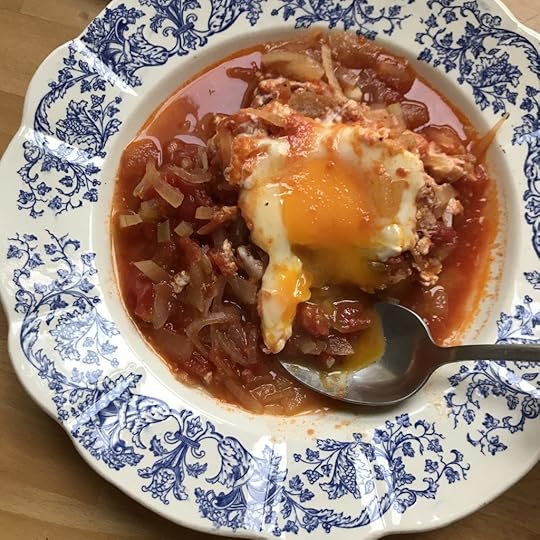

April 25, 2017
French yogurt cake with lemon curd and yogurt whipped cream
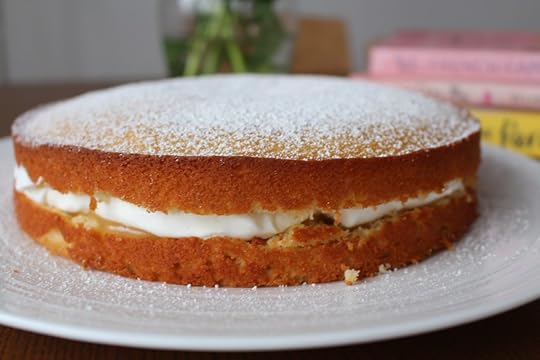
There’s no season in France quite like springtime – and there’s no better way to celebrate springtime in France than with cake and new books! Today I’m thrilled to welcome three beautiful new volumes – a cookbook, an illustrated guidebook, and a memoir – in other words, a book for every room of the house. And because no celebration is complete without something sweet, I also made a lemon yogurt cake with lemon curd and whipped yogurt. Ready? Let’s dive in!
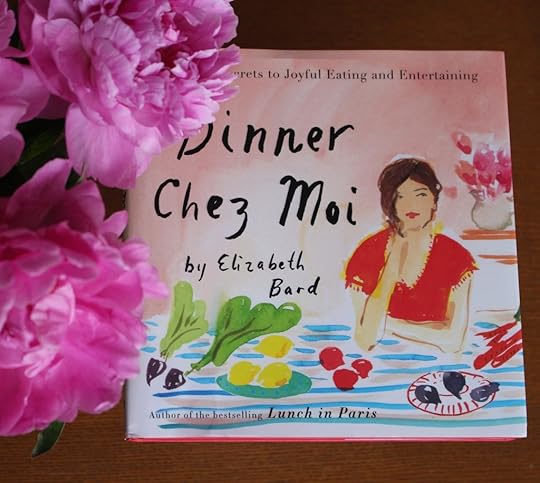
For your kitchen counter:
Perhaps you remember Elizabeth Bard from her delightful memoirs, Lunch in Paris and Picnic in Provence? Well, she’s back with Dinner Chez Moi, a new cookbook that’s like a delightful visit to your girlfriend’s Provençal country kitchen, filled with refreshing gossipy chat and solid advice. The recipes are easy and down-to-earth and, most importantly, they’re the type of food I want to cook – simple, delicious, and moderately healthy. If you’ve ever wanted to know what French people eat everyday, Elizabeth spills the beans (or should I say chickpeas? Ha ha).

For your coffee table:
Paris is a city of contrasts, of Belle Epoque architecture and 21st-century energy. In The New Paris, Lindsey Tramuta profiles the chefs, patissiers, bartenders, brewers, designers, and more who are “fueling a movement” into the future. Lindsey’s discoveries are exciting and fresh, while her impeccable eye makes this the best Paris shopping guide imaginable. Charissa Fay’s accompanying photographs are like a vacation all by themselves.

For your bedside table:
As How to Make a French Family opens, Samantha Vérant is a new bride eager to begin life with her French husband, and step-kids in a suburb outside of Toulouse. Fast forward a few weeks and Samantha is facing flea-ridden cats, grumpy teens, and monumental language barriers. But Samantha perseveres, and in the end her humor, heart (and great recipes) will leave you cheering her on until the last page. Memoirs about moving to France are a guilty pleasure, and you’ll be captured by Samantha’s fish-out-of-water tale.

For the cake:
If there’s one cake every French person knows how to bake, it’s a yogurt cake. Often, they even use a yogurt container to measure out the ingredients, making it less of a recipe than a balance of ratios. As it turns out, a recipe for lemon yogurt cake appears in the books of both Elizabeth and Samantha – and Lindsey’s book kind of reminds me a lemon cake, with its bright and cheerful cover :)
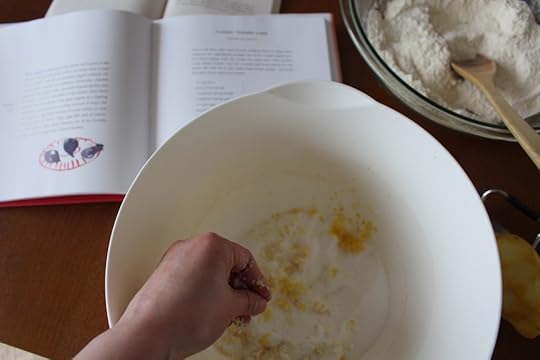
I swapped around a few ingredients, substituting ground almonds for some of the all-purpose flour, because I wanted to use up the tail end of a bag I had in the pantry. Instead of butter, this cake uses yogurt and a bit of vegetable oil, which give it a beautiful, moist texture (and make it healthy-ish). Before mixing the wet ingredients, I took a few extra seconds and rubbed grated lemon zest into the sugar, which is a tip I learned from Dorie Greenspan. The resulting perfume was shockingly intense.
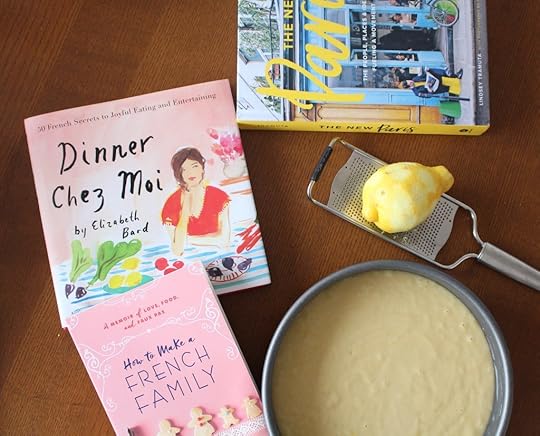
The cake bakes for about 50 minutes, and then cools for a while on a wire rack. You could stop here and eat the cake, just like that. Or you could infuse it with lemon syrup for a drizzle cake. Or you could do what I did, which is really dress it up by slicing it into two layers and filling the center.
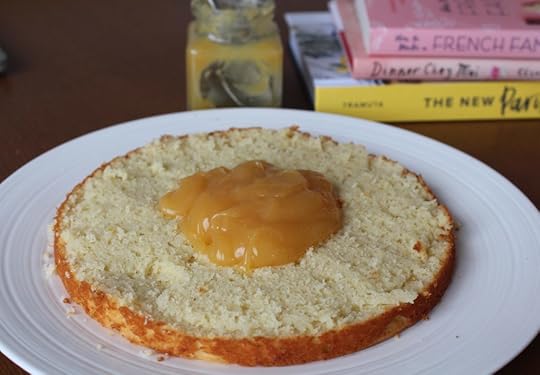
You can use any kind of berry jam, but I opted for lemon curd (from Trader Joe’s), which I think balances just the right amount of sweet and tart.
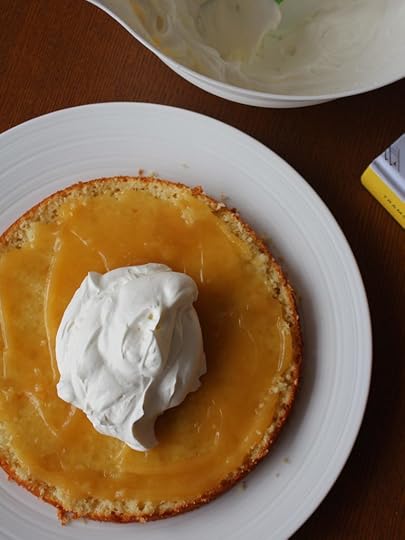
And the icing on the cake, so to speak, is a heap of yogurt whipped cream. This is a trick I learned from Food52 – you can whip up to twice as much yogurt into cream, and it will still form a billowy cloud. I eyeballed about one-third yogurt, to two-thirds cream, and the result was lighter than pure cream, with a tangy and refreshing flavor that pairs beautifully with fresh berries – or lemon cake. And, of course, as everyone knows, nothing goes with lemon cake like books about Paris!

French yogurt cake with lemon curd and yogurt whipped cream
Serves 6 to 8
This is a very forgiving recipe. You can bake it in a round tin, as I have here, or a loaf pan. If you don’t have almond meal, use another 1/2 cup of all-purpose flour. You can fill the cake, or not, or drizzle it with lemon syrup (variation below).
1/2 cup almond meal
1 cup all-purpose flour
2 teaspoons baking powder
1/2 teaspoon salt
Zest of one lemon
1 1/4 cups sugar
1 cup plain whole or low-fat yogurt (not Greek)
3 eggs
1/2 teaspoon vanilla
1/2 cup vegetable oil
To fill the cake:
1/2 cup lemon curd (or more to taste)
1 cup heavy whipping cream
1/3 cup Greek yogurt
1 tablespoon powdered sugar
Preheat oven to 350ºF. Grease a round cake tin or loaf pan and line the bottom with parchment paper.
In a large bowl, stir together the almond meal (if using), flour, baking powder, and salt.
Measure the sugar into a second bowl. With your fingertips, rub the lemon zest into the sugar, releasing an intense perfume (this takes about 20 seconds). Whisk in the yogurt, eggs, vanilla, and vegetable oil.
Slowly combine the wet ingredients with the dry ingredients, making sure everything is incorporated. Pour the batter into the prepared pan and bake for 50 minutes, or until a cake tester inserted in the center comes out clean.
Remove the cake from the oven and cool for 10 minutes. Unmold the cake onto a wire rack and allow to cool completely.
To fill the cake, using a sharp knife, slice the cake through the middle to create two thin layers. Spread the bottom half with lemon curd. To prepare the yogurt whipped cream, combine the whipping cream, Greek yogurt, and powdered sugar in a large bowl. Beat on medium-high speed until soft peaks form. Dollop about half the yogurt whipped cream on the lemon curd, and replace the top layer of cake. Dust with powdered sugar and serve with the extra whipped cream on the side.
Variations:
–Elizabeth uses olive oil instead of vegetable oil. Sometimes she adds 1/2 cup of chocolate chips to the batter.
–Samantha serves her version with sliced strawberries.
–If you’d like to try a lemon drizzle cake, bake the cake in a loaf pan. Reduce the sugar in the cake to one cup. While the cake bakes, prepare a lemon syrup of 1/3 cup sugar and 1/3 cup lemon juice by cooking the two in a small pan until the sugar has dissolved and the mixture turns clear. With the cake still warm, place it on a large plate, and poke holes across the top with a skewer. Spoon the lemon syrup over the cake and allow it to soak in. Cool before serving.

April 18, 2017
Sheet pan chicken hariyali tikka and aloo gobi

To be honest, my usual modus operandi when it comes to fresh herbs is that I use a few sprigs for a special recipe, and allow the remainder to wilt and rot in the bottom of my crisper drawer. But the other day I found myself with a lot of extra cilantro and mint (leftover from making ), and I remembered this chicken recipe from my friend, Mallika Basu, which blends large quantities of herbs into an aromatic marinade. Just to keep things cutting edge, I threw the chicken over a bed of spiced potatoes and cauliflower for a SHEET PAN SUPPER of chicken hariyali and aloo gobi.
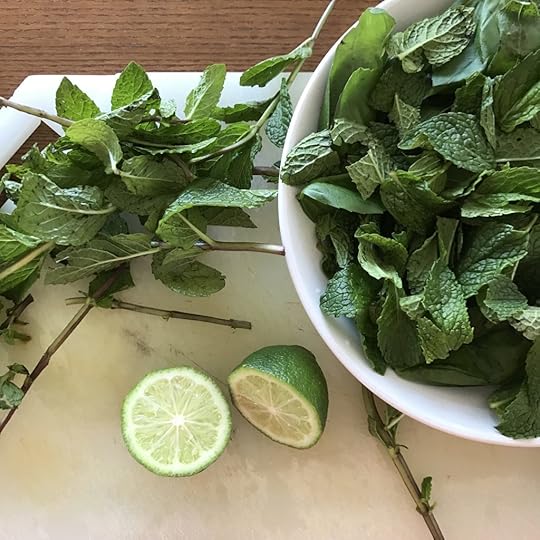
Mallika is the author of my absolute favorite Indian cookbook (and she has another one on the way). Her recipes are admirably authentic, and I should probably take this opportunity to say that my recipe is merely inspired by Indian cuisine – I am sure there are many things about it that would make Mallika, who grew up in Kolkata, cringe. (I am so sorry, Mallika!!!!) Now that I’ve got that off my chest, I can admit that I used lime juice instead of lemon in the marinade – because that’s what I had on hand – and I also added yogurt because it makes chicken so tender.
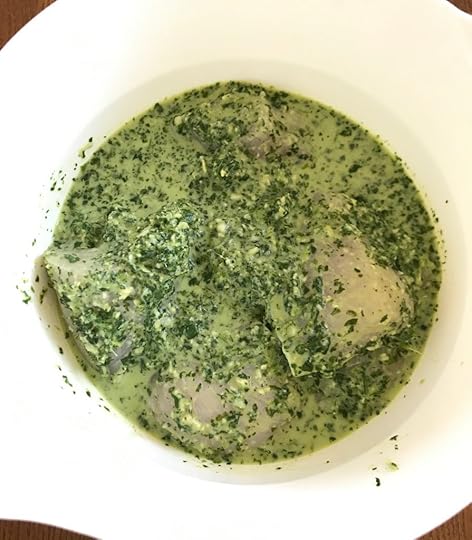
To the marinade, I also added onion, garlic, and ginger – as well as a dash of cayenne pepper, because I didn’t have a fresh chili on hand. The beauty of this recipe is that the chicken actually improves with time – which makes this a perfect weeknight supper – you can prepare everything in advance and pop it in the oven when you get home.

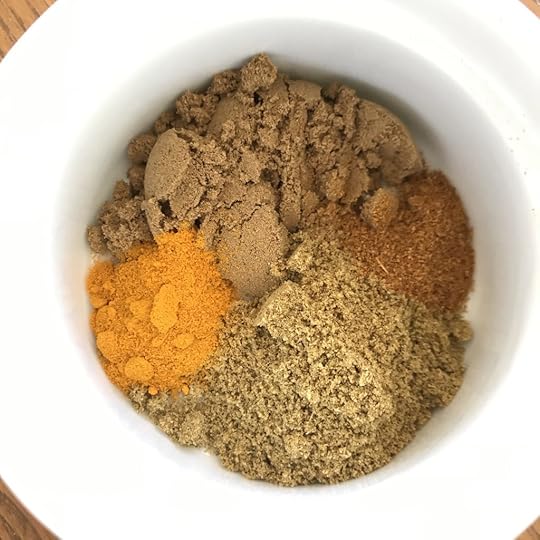
Cauliflower and potatoes are the literal translation of “aloo gobi,” and though the dish is traditionally sautéed, roasting them on a sheet pan makes things easier for the harried (or lazy). This method also has the benefit of turning the vegetables golden brown, especially the slivers of onion, which do not burn, but turn wonderfully sweet and caramelized. Chop your vegetables in advance and – pro tip – measure out the spices in advance, too. Your future self will thank you, trust me.
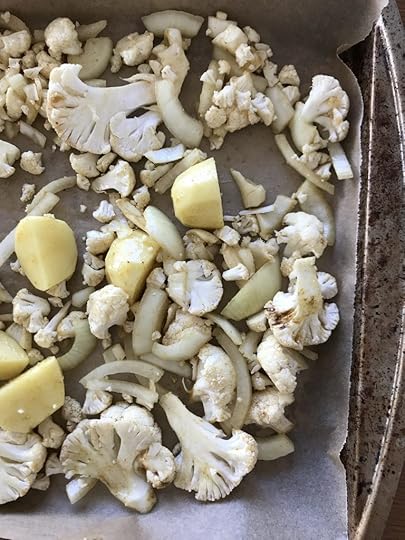
As dinnertime approaches, toss the vegetables with spice mix and arrange them on a sheet pan lined with parchment paper. Give them a good head start in the oven, and then pop the marinated chicken on top, returning the tray to the oven for a few more minutes. Voilà, you’ve got dinner – serve with cucumber raita if you can be arsed (or plain yogurt on those nights when you just can’t).
Sheet pan chicken hariyali tikka and aloo gobi
Adapted from Miss Masala
Serves 2-3
Chicken hariyali tikka
1/2 bunch mint
1/2 bunch cilantro
1/2 onion
2 cloves garlic,
1 green chile
1/4 cup yogurt
Juice of one lemon (or lime)
Salt and pepper
3/4 lb chicken breasts, trimmed into thirds
Pluck the mint leaves from their stems. Roughly twist away the tougher cilantro stems. Peel and roughly chop the onion and garlic. Chop the chile.
In the bowl of a food processor or blender, combine the mint and cilantro leaves, chopped onion, garlic, chile, yogurt, lemon juice, and pepper. Whizz until combined, adding a dash of water if necessary to obtain a smooth marinade. Taste and season with salt.
In a bowl, combine the chicken pieces with the marinade, tossing to coat evenly. Allow to marinate for 10 minutes (or up to a day, covered in the fridge).
Aloo Gobi
1 lb (a small, or half head) cauliflower
4 large new potatoes
1 small onion
1 teaspoon ground coriander
1 teaspoon ground cumin
1/2 teaspoon ground turmeric
1/4 teaspoon cayenne pepper
3 tablespoons neutral oil (such as canola)
Salt
Cut the cauliflower into florets. Peel and quarter the potatoes. Peel and slice the onion.
When you are ready to cook, preheat the oven to 425ºF. Line a sheet pan with parchment paper. In a bowl, toss the onions, cauliflower, and potatoes with the spices, oil, and salt (to taste) until everything is evenly coated. Spread the vegetables on the sheet pan and roast for 20 minutes.
Remove the sheet pan from the oven and toss the vegetables. Nestle the chicken into the vegetables, slathering each piece with excess marinade. Return the pan to the oven and cook for 10-15 minutes until the chicken is completely cooked. Serve with cucumber raita or plain yogurt.

April 10, 2017
Vegetarian Vietnamese noodle salad from Farm to Table Asian Secrets
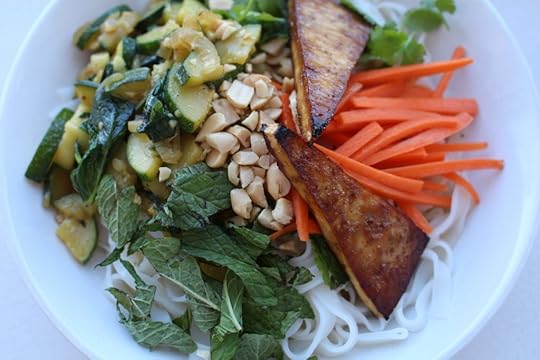
I don’t usually associate Paris with (good) Asian food (sorry). But while researching this article on non-French spots in Paris, I remembered how much I love a Vietnamese-inspired noodle salad that’s beloved in the City of Light. The French call it bò bún (pronounced “bo boon”), though in Vietnam and elsewhere the same dish is named bún bò. It’s a summery salad of rice noodles that have been tossed with a light dressing of fish sauce, sugar, and lime juice, and topped with fresh herbs, chopped peanuts, slivered vegetables, sautéed lemongrass-scented beef, and a crispy pork spring roll (called nem in French, and chá giò in Vietnamese).
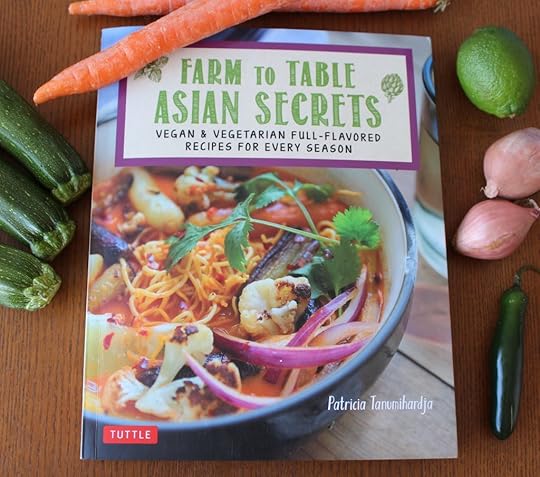
Thanks to a new wave of hotspots in the Marais and Canal Saint-Martin, bò bún is a . (One of my favorites is at Le Petit Cambodge, which is reopen again after being targeted in the terrorist attacks of November 2015.) But outside of France, the dish is more elusive – and so I was excited to cook my own vegetarian version, based on recipes from my friend Patricia Tanumihardja’s new cookbook, Farm to Table Asian Secrets.
Pat and I met a few years ago when we were both brand-new authors, and she quickly became one of my favorite Asian food writers. Born in Indonesia, she grew up in Singapore, (ie Asian food mecca), and is now based in Washington, DC, where she writes a blog, Pickles and Tea, for the Smithsonian.
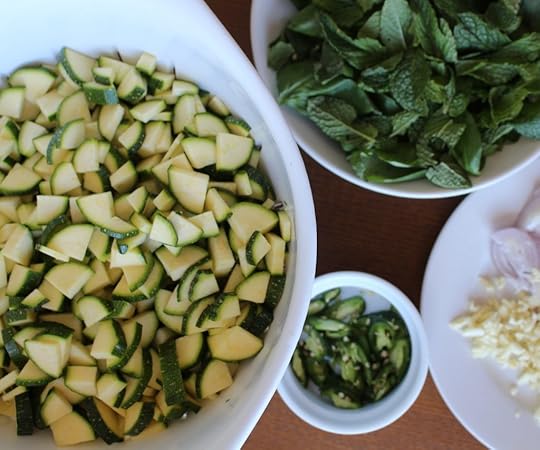
If, like me, you suffer from farmer’s market paralysis – unwilling to spend big bucks at the local produce stand because you don’t really feel like cooking any of that stuff – Pat’s new book, Farm to Table Asian Secrets: Vegan and Vegetarian Full-Flavored Recipes for Every Season, will provide a wealth of inspiration. Organized by season, the recipes call for common American or European vegetables – like fennel, crookneck squash, and parsnips – giving them a distinct Asian spin. For example, Pat’s tosses fiddlehead ferns (or Swiss chard) with sesame sauce. She tucks celery root into spring rolls, and laces red curry with fava beans (in the spring), or kabocha squash (in the autumn). The result is a celebration of local and seasonal produce with, as Pat says, “the Asian spark.”

The book has a recipe for Vietnamese noodle salad bowls, topped with shiitake mushrooms, broiled tofu, and Pat’s own vegan “fish” sauce (which is flavored with kombu). But I was craving the hot-cold combination of bò bún, which mixes fresh herbs and vegetables with slippery noodles and stir-fried lemongrass beef and onions – so I decided to mix-and-match a few recipes from the book and create my own. In lieu of lemongrass beef, I made Pat’s Thai basil zucchini, which has similar flavor notes – sweet, savory, and spicy. I mixed up a dipping sauce of fish sauce, lime juice, water, and sugar – and I abstemiously substituted the book’s broiled tofu for a spring roll. Sprigs of fresh cilantro, mint, crushed peanuts, and slivered carrots topped the dish (and if you’re feeling fancy, the book has a recipe for quick-pickling the latter).
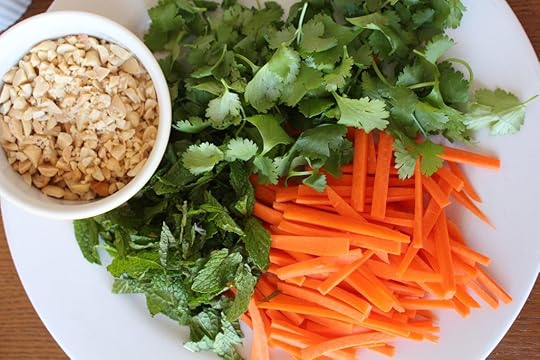
I admit this meal combines several elements, and they all took a little more time than I had initially anticipated. But the result was fresh, light, and – with that glorious hint of mint – very springy. As the days grow warmer, and the farmers market comes back to life again, I look forward to using this wonderful book more and more.
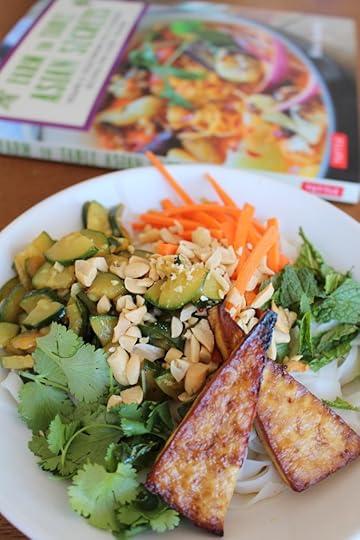
Vegetarian bò bùn (Vietnamese noodle salad)
Adapted from Farm to Table Asian Secrets by Patricia Tanumihardja
Note: This recipe is almost completely vegan – except I used fish sauce. If you’d like to make your own vegan fish sauce, Viet World Kitchen has a recipe here, which is similar to the one in Pat’s book.
Serves 2-3
Sauce
1/4 cup fresh lime juice
2 tablespoons fish sauce
2 tablespoons brown sugar
1/2 cup water
Noodles and garnishes
8 oz rice noodles
Handful of fresh cilantro and mint leaves
1/2 cup roasted peanuts, crushed
1 carrot, cut into matchsticks
Broiled tofu
1 tablespoon soy sauce
1 tablespoon vegetable oil
1 teaspoon warm water
2 tablespoons brown sugar
Thai basil zucchini
2 tablespoons vegetable oil
2 tablespoons minced garlic
1/2 cup sliced shallots
1.5 lbs zucchini, quartered lengthwise and cut crosswise into triangles
1/4 teaspoon fine salt
2 to 3 Thai chilies, chopped (or to taste)
2 tablespoons soy sauce
2 teaspoons dark brown sugar
1 cup fresh basil leaves
1/2 cup fresh mint leaves
Black pepper
To prepare the Sauce, stir together the lime juice, fish sauce, brown sugar, and water in a medium bowl. Taste and adjust seasonings.
To cook the rice noodles, bring a large pot of water to a boil over high heat. Add the noodles and cook until tender, 3 to 4 minutes. Drain in a colander and rinse with cold running water until the noodles are cool. Drain well in a colander and set aside for up to 2 hours at room temperature.
To prepare the Broiled Tofu, drain the tofu by placing it between two rimmed plates. Carefully place a heavy weight on top – I used a container of rice and a can of tomatoes – and allow to drain for 10 to 15 minutes. Meanwhile, stir together the marinade ingredients in a bowl. Arrange the oven rack at the highest level. Preheat the oven’s broiler to high. Cover a baking sheet with parchment paper. Remove the drained tofu and pat it dry with paper towels. Cut the block of tofu into 16 triangles. Arrange the tofu pieces on the baking sheet and spoon marinade over each one, on both sides. Broil the tofu until golden and crisp, about 3 to 5 minutes. Flip the tofu and broil for 2 to 3 more minutes, until seared and golden.
To prepare the Thai Basil Zucchini, swirl the oil in a large wok or skillet set over medium heat. When the oil shimmers, add the garlic and shallots, cooking until fragrant, about 30 seconds. Raise the heat to high and add the zucchini and salt. Stir to combine, and cook until the zucchini is lightly browned and translucent, 8 to 10 minutes, covering the pan if necessary. Reduce the heat to medium, and add the chilies, soy sauce, and sugar, stirring to combine. Stir in the basil and mint. Cook until the basil is wilted and fragrant, about 1 to 2 minutes.
To prepare the Noodle Salad, divide the noodles between 2 or 3 shallow pasta bowls. Drizzle 2 to 3 tablespoons of dipping sauce of the noodles and toss to combine. Reserve the rest of the sauce to serve at the table. Top the noodles with the piping hot zucchini, mint and cilantro, slivered carrots, peanuts, and 2 slices of broiled tofu. Serve, passing the additional sauce at the table.

March 21, 2017
Spring giveaway!
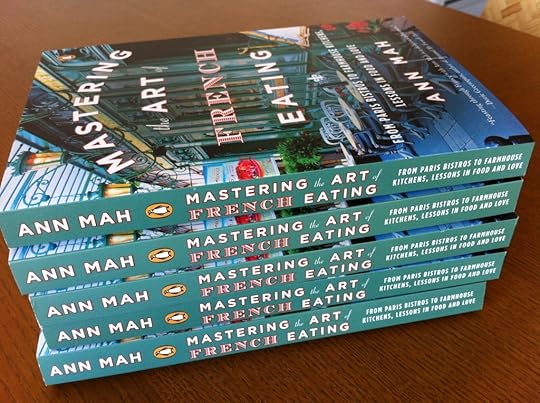
I don’t know about you, but there’s something about longer days and milder temperatures that makes me want to travel. If you’re dreaming of France, why not take an armchair trip with a signed copy of Mastering the Art of French Eating? I have two copies to give away! (If you already have your own copy, it makes a great gift for a friend.)
If you subscribe to my newsletter, you’re already entered to win. (Or you can subscribe here.) One randomly selected winner will receive a signed copy of the book. I’ll announce the winner here on my blog on Wednesday, March 29.
For a second chance to win the giveaway, visit my author page on Facebook and enter there.
Thanks – and bonne chance!

February 22, 2017
Winter tabbouleh
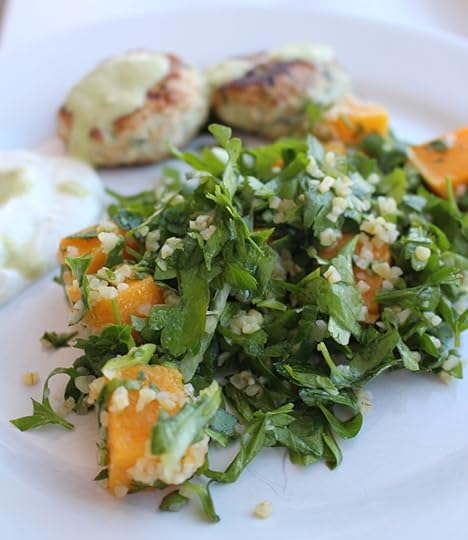
Earlier this month, I was in Paris for a week – only a week – but still utterly wonderful. Often these trips are like a death march, as I try to cram too much research and home maintenance into too little time, but this time I was on a writing retreat – no cooking, no childcare, only writing. As I gratefully told my husband, it was like a spa for the mind.
Though I loved my hours of at-home solitude, I have to admit that there is a certain guilt in going to Paris and not doing anything. At times I felt like I was wasting the experience of being there – surely I should be out, absorbing the sights and smells of the city I love? Surely I should be eating food other than buttered tartines and Picard? Surely I should be seeing friends? (Please forgive me for not getting in touch, friends!) And then bright rays of sunlight would shoot through my kitchen windows, and I’d start a load of laundry and settle down to wrestle with another paragraph.
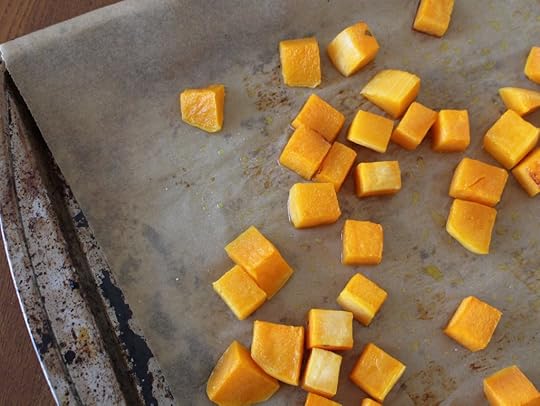
The good news is, a week of living like a hermit left me feeling virtuous and productive. Most of all, I loved slipping into my own rhythm in the city, waking late (I never got over jet lag), eating small meals whenever I felt hungry, slipping out to buy a half a baguette at dusk, and working way past my normal bedtime. And while I did make a few great food discoveries – which I’ll report on in my March newsletter (you can sign up here) – I have to say that one of the best things I ate was actually at the airport while waiting for my flight home.
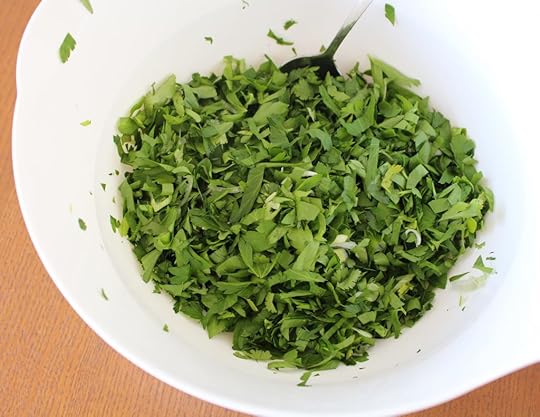
I know – airport food. Yuck. Like you, I’d rather eat anything else. But sometimes it’s unavoidable, and I’m happy to say that the branch of Exki at Charles de Gaulle Terminal 2 is not half bad, the quiches and tarts constantly restocked, the salads fresh, the cheese platters quite tempting. I picked up a terrific tabbouleh salad here – unlike most tabbouleh in France, it used cracked wheat instead of couscous, tossing the grain with loads of chopped parsley – and cubes of roasted butternut squash.
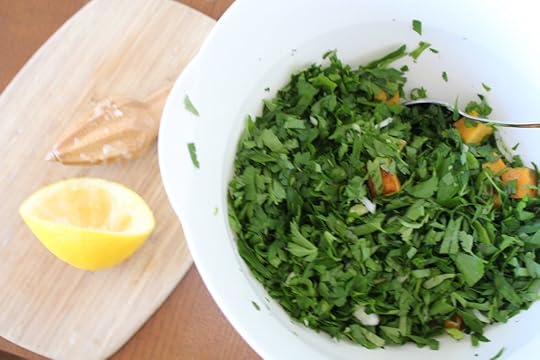
As you probably know, tabbouleh is traditionally a summer salad of fresh herbs, tomatoes, and cucumbers, a scant amount of grain – bright and refreshing – dressed with lemon juice and olive oil. But why not create a winter version, too? These days, parsley, mint, and scallions are available year-round – and they pair beautifully with winter squash – chunks of butternut, acorn, or even sweet potato would all be delicious. When I made this at home, I also threw in the last few sprigs of cilantro hanging out in my crisper, so really any herb goes, as long as they don’t overpower.
There is, admittedly, a fair amount of work to making tabbouleh – washing the herbs, drying them, plucking the leaves, finely chopping them – these are my least favorite kitchen tasks (clearly, I need to keep training my sous chef). But if you turn on NPR, it goes faster than you think – and you can bask in the virtue of using up that pesky bunch of parsley you have on hand from another recipe (like these meatballs).
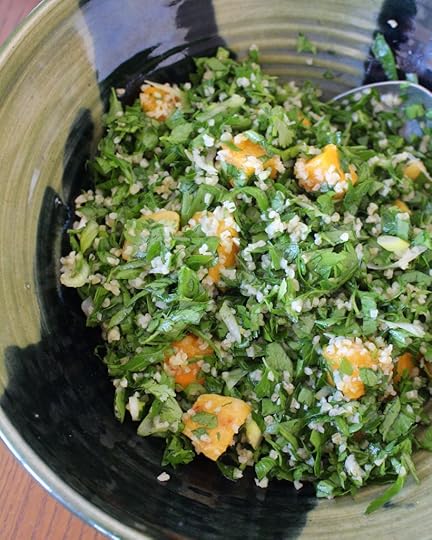
We ate the tabbouleh for lunch with Ottolenghi’s turkey and courgette burgers, but I think grilled halloumi cheese would also be delicious. I’m going to try that next time.
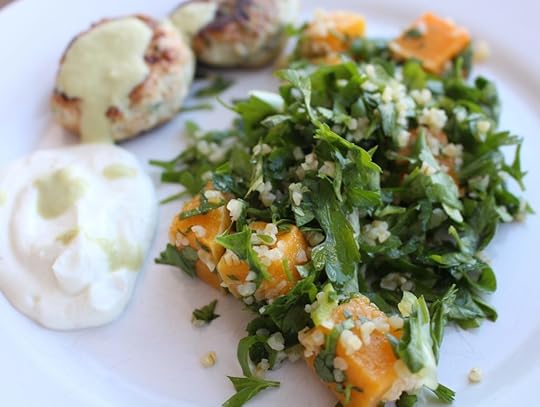
Winter tabbouleh with butternut squash
Serves four
250 grams butternut squash
1/3 cup bulgur wheat
1 large bunch parsley
1/2 bunch mint
3 green onions, washed and trimmed
1 lemon
Extra virgin olive oil
Salt and pepper
Preheat the oven to 400ºF. Peel and cube the butternut squash. (The best method I have found is via Elizabeth Minchilli here.) Toss the squash with olive oil, salt, and pepper. Spread it on a baking sheet lined with parchment paper and roast until soft, about 30 minutes.
Meanwhile, place the bulgur wheat in a small bowl, cover with boiling water, and leave for five minutes. Drain in a strainer, allowing the excess water to drip through.
Wash and dry the parsley and mint. Pluck the leaves from the stems. Finely chop the leaves and add to a large bowl. Thinly slice the scallions and add them to the bowl, along with the bulgur wheat, and cooled butternut squash. Toss together with the juice of half a lemon, 1/4 cup olive oil, salt and pepper. Taste and adjust seasonings, adding more lemon juice if desired.

January 24, 2017
How to eat congee (rice porridge)

As you might have noticed from my new monthly newsletter ***why, yes, that was a shameless plug for my newsletter! It comes out once a month, and offers restaurant and travel tips, book recommendations, and more. You can sign up here*** I have fallen hook, line and sinker for hygge, the Danish concept of coziness / curmudgeonliness that has become a new American obsession (thanks in part to this article). Things that are hygge include: cable knit sweaters, thick blankets, candles, sipping hot drinks, and watching police procedurals on TV. But perhaps the most hygge of All Things Hygge is… Porridge!
It turns out Danes love love love porridge. In Copenhagen, there is an entire chain of restaurants called Grød – the name translates to “porridge” – which serves the stuff at breakfast, lunch, and dinner. When I learned about it, I was ready to hop on a plane and spend a week slurping. Happily, Grød’s concept has been replicated much closer to home at the Great Northern Food Hall, the new Danish food court in New York’s Grand Central station, where the Grain Bar dishes up porridge from dawn to dusk, from oatmeal, to øllebrød – a traditional Danish porridge made from beer-soaked rye bread that sounds… interesting? I would like to try it, anyway – to savory porridges that are actually “grainottos” – that is, grain risotto – I loved a version with farro, chicken, sautéed cabbage, and crispy chicken skin garnish.
In truth, I’ve had porridge on my mind ever since our Christmas visit to Southern California, an annual trip full of sunshine, tacos, and delicious leftovers from my parents’ groaning fridge. I’m not sure what inspired me to heat up a bowl of rice porridge for my first breakfast there, but I did, and I loved it so much that I ate it every single morning of my visit. Chinese rice porridge is what my mom believes people want to eat after a long journey. It’s what you eat when you’re under the weather. And, in many parts of China, it’s breakfast. “I used to eat it every morning with pickled vegetables and, on special holidays, a preserved duck egg,” said my mother, sharing a lovely gustatory memory. (These days she eats bran cereal.)
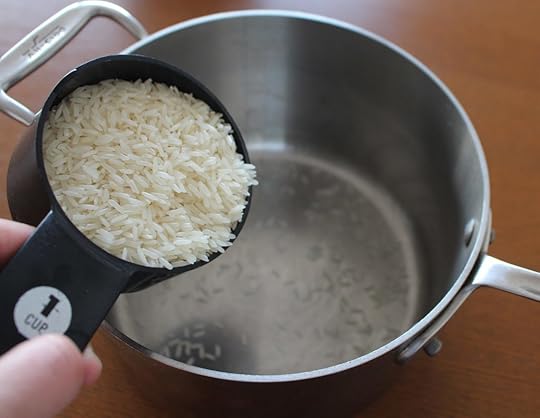
Rice porridge exists in many Asian cultures, with many different names. In English, it’s often called “congee,” which Wikipedia says is from a Tamil word, kañci, “a prominent food of ancient Tamil people.” Growing up, we used its Cantonese name, jook (rhymes with look), and in Mandarin it’s known as zhou, which is sort of pronounced like “joe” – make sure to sing the word as a single note; aim for F on the musical scale.
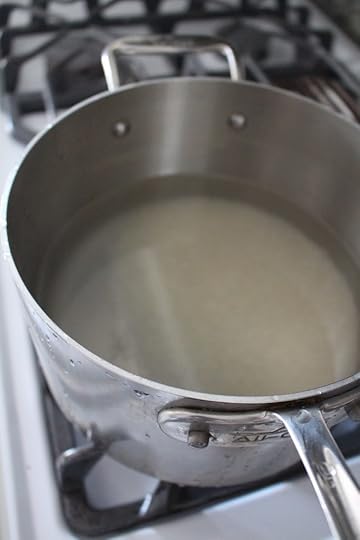
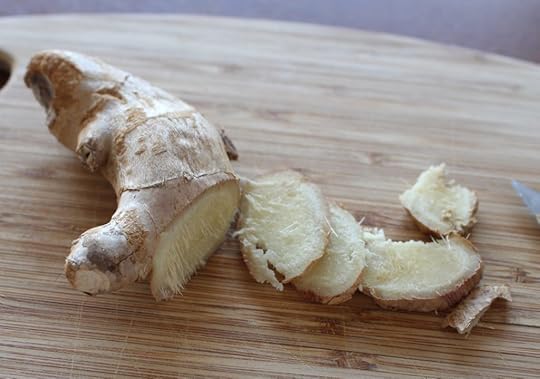
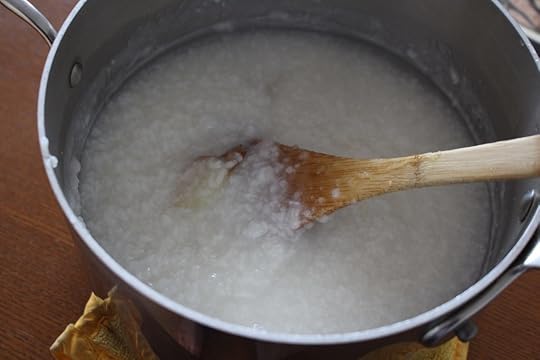
The internet is full of recipes for fancy zhou (as I will forever call it, after four years of living in Beijing), incorporating things like chicken, stock, and/or scallions. And don’t get me wrong, that kind of zhou is delicious – it’s just not what I grew up eating. The zhou of my childhood is plain, except for a few slices of ginger. And it is ridiculously easy to make – simply simmer rice with water and ginger until the grains completely disintegrate. Don’t be shy about adding more water as the mixture cooks – nearly every photo I’ve seen online features zhou that looks way too thick (in my opinion) – personally, I prefer it soupier, more like a light chowder than a rice pudding.

So, now you have a bowl of extremely bland, soupy rice and maybe you’re thinking, seriously? But, wait! This is when we add the condiments! Think of zhou as your blank canvas to adorn with pickles, sauces, herbs, vegetables. Feather a scrambled egg into the pot, if that’s your thing, stirring it into a silken mass. Add the leftover mapo doufu from Friday night’s takeout. Sprinkle over some of that pork floss stuff, which is so incredibly freaking delicious, but also possibly the leading cause of heart attacks in Asia.
Here’s what I did: The other day, needing to escape all forms of news media, I spent a few hours in New York’s Chinatown, elbowing my way through the aggressive grannies at the Chinese supermarket. With zhou already on my mind, I grabbed a bunch of cilantro, a bag of roasted peanuts, a jar of chili bamboo shoots. And I hunted down this sauce, which my dear friend, Lee – Beijing expat veteran – described as “delicious spice. You can put it in zhou and on everything. Some people live and die by it.”
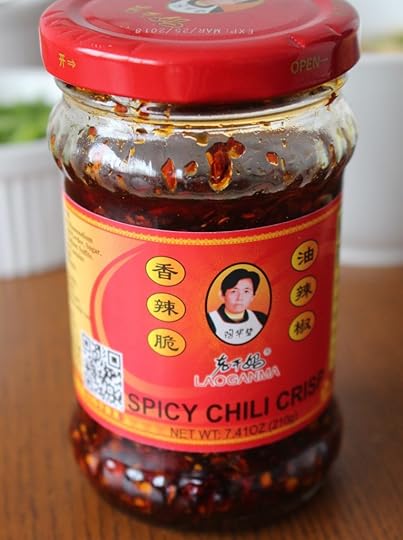
The sauce is called Lao Gan Ma spicy chili crisp and though it may look like your typical chile oil, it’s actually a crunchy, spicy elixir unlike anything I’ve ever tasted. Even just opening the jar and breathing in its savory perfume makes my mouth water. There are red pepper flakes, but also tongue-tingling Sichuan peppercorns, bits of caramelized onion, fried soy beans adding crunch and texture, a hint of salt. The result is a spicy, but far from searing – it’s a reasonable heat – and also utterly addictive. If you don’t currently have a bottle in your cupboard, I suggest you sprint to the nearest Chinese grocery store and buy one.

As it turns out, zhou has lifted me from my daily breakfast rut. For a few months, I’ve been searching for a new option – tired of toast, not a fan of oatmeal, too much of a hypochondriac to eat eggs every day. But now I look forward to a bowl of zhou, freshly microwaved, with cilantro (for vitamins), peanuts (for protein), soy sauce (for seasoning), and a generous spoonful of crisp chili sauce (for my mental health). Just in time for Chinese new year – which is this coming Saturday! – congee has made mornings great again. Happy year of the rooster!
Rice porridge / congee / jook / zhou / call it what you will
This is the plainest of zhou, but also the easiest (and hardly a recipe). Serves four.
1 cup white rice (not long-grain)
3-4 slices fresh ginger
Water
In a deep saucepan and wash the rice, rinsing until the water runs clear. Cover the rice with one inch of cold water. Add the sliced ginger. Bring the pot to a boil and lower to a simmer, cooking gently until the rice has completely disintegrated, about 30-45 minutes, adding more water if the mixture becomes too thick.
Related links
Ginger chicken rice porridge (Chowhound)
Brown rice and gai lan rice porridge (Chowhound)
Chicken congee (New York Times)
Millet zhou (Madame Huang’s Kitchen)
Seafood congee (Omnivore’s Cookbook)






